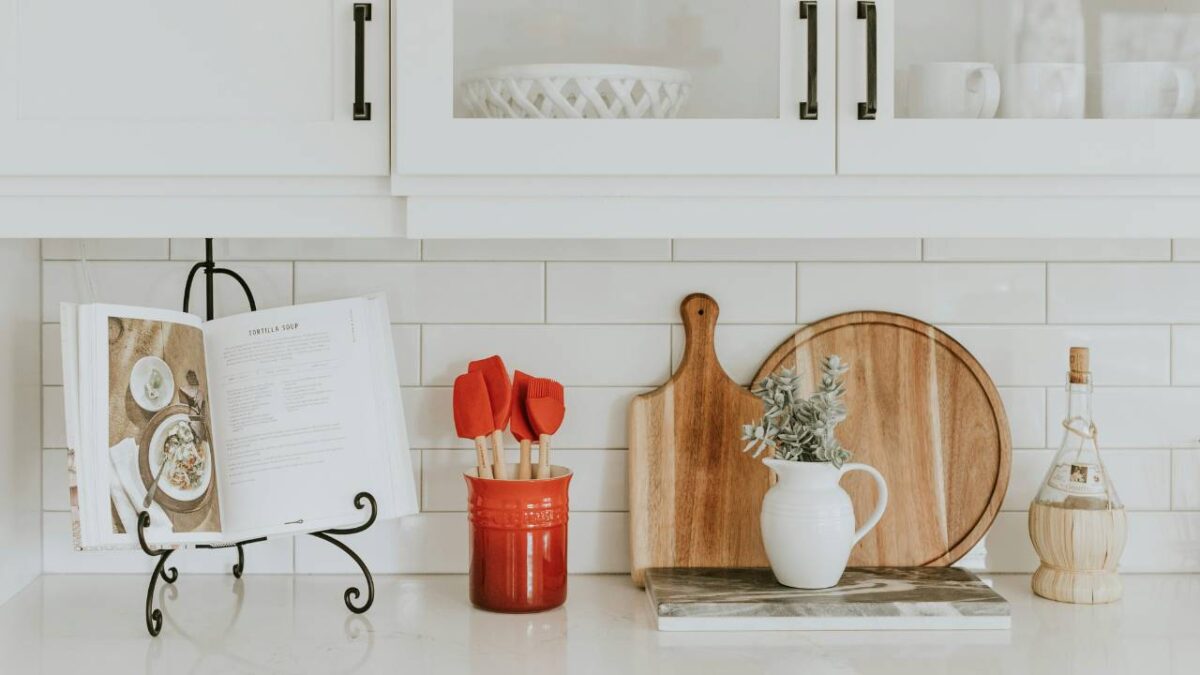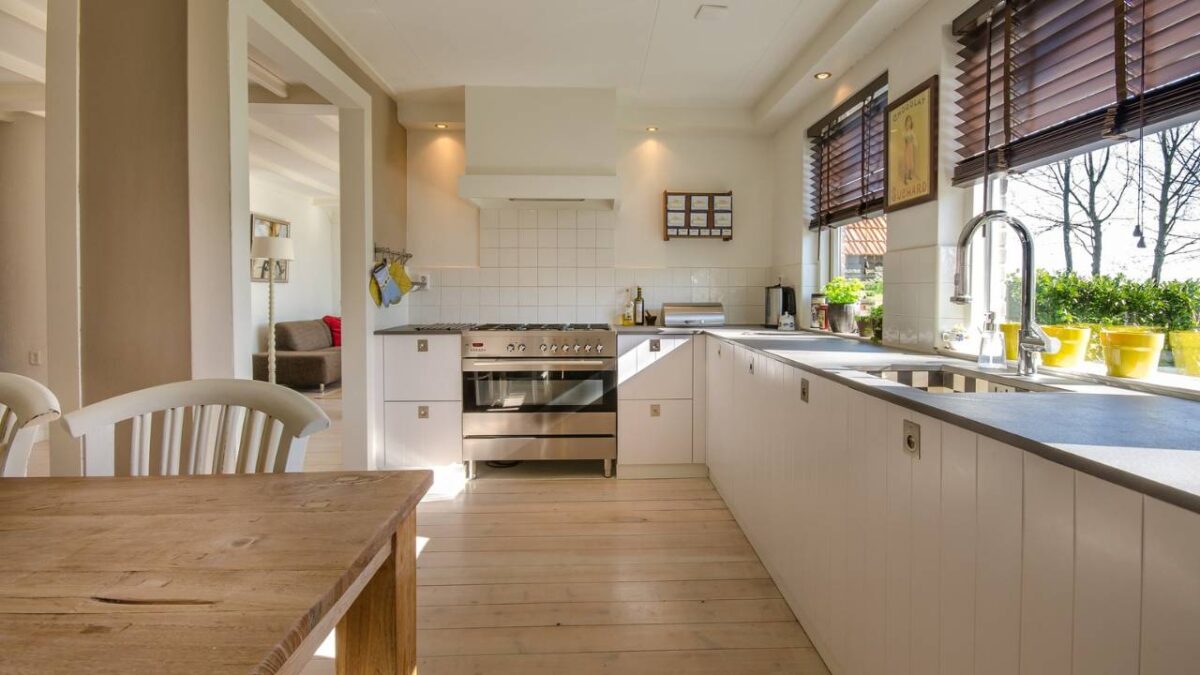How to design your perfect kitchen? It can be an exciting yet challenging task. Whether you’re planning a full renovation or simply updating certain elements, the key to a beautiful and functional kitchen lies in careful planning and attention to detail. From selecting the right materials to choosing a cohesive colour palette, there are numerous factors to consider.
One of the most important aspects of kitchen design is maximising space. This can be achieved through smart storage solutions and efficient layouts. Incorporating modern appliances that blend seamlessly with your design will not only enhance functionality but also add a touch of elegance. Don’t shy away from mixing textures and finishes to create a dynamic and visually appealing space.
Lighting plays a crucial role in setting the mood and enhancing the overall look of your kitchen. Choose a combination of ambient, task, and accent lighting to create a well-lit and inviting atmosphere. Thoughtful placement of lights can also highlight key features of your kitchen design and make the space feel larger and more open. By considering these elements, you’ll be well on your way to creating a stylish and inviting kitchen that perfectly suits your needs.
Planning Your Kitchen Layout
Creating a functional and stylish kitchen involves thoughtful planning of your layout. Consider the type of kitchen that suits your space, optimise every inch in smaller kitchens, think about workflow efficiency, and harmonise cooking areas with dining and living spaces.
Determining Your Kitchen Type
Your kitchen layout depends on the available space and your personal needs. There are several common layouts: U-shaped, L-shaped, galley, and island kitchens.
A U-shaped layout provides ample storage and work surfaces on three sides. This type is ideal for larger spaces.
An L-shaped kitchen fits well in open-plan areas, making it easier to integrate with your living room or dining area.
Galley kitchens, with two parallel counters, are perfect for narrow spaces.
An island kitchen allows for additional counter space and storage, making it a favourite for social cooks who enjoy having company while they prepare meals. Companies like Shalford Kitchens can customise these layouts to suit your preferences seamlessly.
Maximising Space in Small Kitchens
Small kitchens can still be highly functional with clever design. Prioritise vertical storage with tall cabinets and open shelving to utilise walls effectively. Opt for built-in appliances to save space and maintain a cohesive look.
A pull-out pantry can provide extensive storage without sacrificing floor space. Consider folding or extendable work surfaces that can be tucked away when not in use. Use light colours to make the area feel more spacious and inviting.
Considering Workflow
Efficient workflow in the kitchen is essential for smooth cooking experiences. Follow the kitchen triangle rule, placing your sink, stove, and refrigerator at optimal distances from each other to minimise unnecessary movements.
Ensure you have clear and ample work surfaces between these key points, allowing for food preparation and cooking activities.
Position frequently used items within easy reach, and consider the flow of movement from the entry of your kitchen to your cooking area.
Integrating Dining and Living Areas
An open-plan layout merges the kitchen with dining and living areas, perfect for modern living. Create a seamless transition by using consistent materials and colours across these spaces.
A kitchen island or peninsula can act as a natural divider while providing extra seating and work surfaces. Install lighting that complements both cooking and dining functions to enhance the ambiance.
Consider acoustics and ventilation to manage cooking sounds and smells. In this setup, smart storage solutions keep the kitchen tidy, allowing it to blend effortlessly with your living areas.
Budgeting Wisely

Carefully managing your kitchen budget is essential for achieving a stylish and functional space. By focusing on the key areas for investment and choosing economical materials, you can create an impressive kitchen without breaking the bank.
Prioritising Investments
Decide where to allocate most of your budget based on your priorities. Quality appliances often top the list, as they are crucial for day-to-day functionality. Investing in durable and efficient appliances, such as a reliable refrigerator or versatile oven, ensures longevity and performance.
Another critical area is countertops. Durable materials like quartz or granite may be more costly but offer great value with their long lifespan and resistance to wear. Spending more on high-use areas can save money on frequent replacements or repairs.
Cabinetry is another significant investment. Choose well-constructed, classic designs that will stand the test of time. Custom cabinetry might be expensive, but pre-made options can be just as stylish and structurally sound. Focus on pieces that blend aesthetic appeal with practical storage solutions.
Cost-effective Materials
When aiming to stretch your budget, selecting cost-effective materials is key. Laminates and vinyl are wallet-friendly alternatives for countertops, offering a vast range of styles and finishes that mimic more expensive options. These materials provide durability while keeping costs low.
Incorporate budget-friendly materials in less critical areas. For instance, MDF (medium-density fibreboard) cabinets can look just as sleek as solid wood but come at a fraction of the price. They are also easy to paint, allowing for customisation without extra cost.
Opt for cost-efficient flooring such as ceramic tiles or vinyl planks. These materials are not only durable but also available in various styles, replicating more luxurious finishes like hardwood or stone without the hefty price tag.
Choosing the Right Appliances
Selecting the ideal kitchen appliances involves balancing your needs with smart technologies that enhance both functionality and style. It’s vital to invest in essentials while considering innovative kitchen solutions that can make cooking and cleaning more efficient.
Essential Kitchen Appliances
Focus on the must-haves that form the backbone of any stylish kitchen. A high-quality refrigerator is paramount, keeping your ingredients fresh and organised. Opt for models with adjustable shelving and smart storage solutions.
Next is the oven – a crucial element for any home cook. A dual-fuel oven offers the best of both worlds, with the ease of an electric oven and the control of a gas hob. For those who entertain often, a double oven might be worth the investment.
Don’t overlook the dishwasher. Modern dishwashers not only save you time but also reduce water and energy consumption. Choose a model with multiple wash settings and quiet operation to ensure it fits seamlessly into your kitchen routine.
Innovative Smart Features
Incorporate appliances with smart features to bring your kitchen into the future. Smart refrigerators can notify you when you’re running low on groceries or suggest recipes based on the items inside. Look for ovens with Wi-Fi connectivity so you can control cooking settings from your smartphone.
Include a coffee machine with programmable settings to enjoy a perfect brew every morning. Some models even allow you to start brewing remotely. By incorporating these modern kitchen solutions, you can streamline daily tasks and enhance your cooking experience.
Smart dishwashers can be operated remotely, allowing you to start a cycle from wherever you are. This can be a game-changer in managing your household chores more efficiently.
Cabinetry and Storage Solutions
Choosing the right cabinetry involves selecting styles and finishes that match your aesthetic, while open shelving can enhance functionality and ease of access. Proper organisation of utensils and dishware maximises space and efficiency.
Cabinet Styles and Finishes
Your choice of cabinet style and finish can set the tone for your entire kitchen. Shaker cabinets offer a classic look with clean lines, perfect for a timeless kitchen design. For a more modern approach, you might opt for flat-panel cabinets which offer a sleek, minimalist appearance.
Finishes are also crucial. Natural wood adds warmth, while painted finishes offer a wide range of colours to match your decor. Glass doors can add elegance and allow you to showcase attractive dishware. Don’t forget the impact of knobs and handles; they can add character or blend into the background, depending on your choice.
Enhancing Functionality with Open Shelving
Open shelving can make your kitchen feel more open and accessible. By choosing sturdy materials, you ensure they can hold heavy dishware and other kitchen items. Well-designed shelving helps in displaying attractive pieces and keeping frequently used items within easy reach.
You might choose to mix open shelves with traditional cabinets for both practical and aesthetic balance. Thoughtfully arrange your items, combining function and style. Make use of decorative containers and baskets to keep the shelves tidy and visually appealing.
Organisation for Utensils and Dishware
Efficient organisation is key to a stylish and functional kitchen. Start by grouping utensils by type and frequency of use. Drawer organisers can help keep everything in its place, preventing clutter. Pull-out trays and racks in cabinets can make accessing pots and pans easier.
For dishware, consider the placement of shelving and cabinets to keep everyday items within arm’s reach. Use dividers and stackable racks to maximise space. By organising thoughtfully, you’ll not only enhance your kitchen’s functionality but also create a more pleasant cooking experience.
Materials and Surfaces

Choosing the right materials and surfaces is essential for a stylish, functional kitchen. This includes selecting appropriate countertops, vibrant backsplashes, and durable yet stylish flooring options.
Selecting Countertops and Worktops
When picking countertops and worktops, think about both style and function. Granite, with its natural beauty and durability, stands out. It’s heat-resistant and offers a range of colours. Quartz, on the other hand, works well if you want a sleek, uniform look. It’s also scratch-resistant and non-porous, requiring minimal maintenance.
Marble is another luxurious option, bringing elegance to your space. However, it requires careful sealing and maintenance due to its porous nature. Laminate worktops are budget-friendly and come in various designs, making them a versatile choice. Each material has its unique qualities, so consider what best suits your kitchen’s design and usage needs.
Backsplash Ideas that Pop
A striking backsplash can elevate your kitchen’s look. Subway tiles are a classic choice, offering a timeless appeal. You can arrange them in different patterns, like herringbone or vertical stacks, to add interest. If you prefer something bolder, glass or metallic tiles can bring a modern, sleek touch to your space.
Natural stone backsplashes, like travertine or slate, add texture and warmth. These materials work well for a rustic or traditional kitchen. For a more artistic vibe, consider mosaic tiles. They come in various shapes, sizes and colours, allowing you to create unique patterns. Remember, your backsplash should complement your countertops and worktops, tying the entire kitchen together.
Flooring Options for Durability and Style
Choosing the right flooring balances durability and style. Porcelain tiles are a top pick as they are hard-wearing and come in numerous designs, mimicking the look of wood, stone, or concrete. They are also water-resistant, making them ideal for kitchen spaces. Hardwood floors offer a warm, classic look but require proper sealing to prevent water damage.
Vinyl flooring is another excellent choice. It’s budget-friendly, easy to install, and available in various styles. If you’re looking for a high-end option, consider stone tiles like travertine or marble. These materials add a touch of luxury and are incredibly durable when properly maintained. Your flooring choice should complement the overall aesthetic and withstand the kitchen’s daily activities.
Lighting and Electrical Considerations
Effective lighting enhances the kitchen’s beauty while practical electrical placement ensures functionality and ease of use. A balance between natural and artificial lighting can create a welcoming atmosphere and allow for focused activities.
Creating Ambience with Lighting
Using various light sources can transform your kitchen into a versatile space. Ambient lighting, such as ceiling-mounted fixtures or recessed lights, gives general illumination. Task lighting, like under-cabinet fixtures, helps when preparing food. Consider accent lighting to highlight features like open shelving or an island.
Natural daylight is a valuable asset. Large windows, skylights, or glass doors can flood the kitchen with light. It creates a bright, airy feel, making the space look bigger. Mirrors or reflective surfaces can also amplify daylight.
Dimmable light switches grant flexibility. Lower the lights during a cosy dinner or raise them while cooking. Mixing warm and cool light bulbs can make the kitchen feel inviting yet practical.
Practical Placement of Electrical Outlets
To maintain functionality, electrical outlets must be thoughtfully placed throughout your kitchen. Position outlets above the countertops for easy-access to small appliances like kettles or toasters. Ensure there’s sufficient spacing to avoid clutter.
Adding outlets into an island or peninsular provides flexibility. It’s convenient for prep work, charging devices, or while entertaining. Consider pop-up outlets for a sleeker look when not in use.
Outlets inside cabinets or drawers can hide charging stations for devices, keeping the worktops tidy. Don’t overlook the fridge, oven, and dishwasher—dedicated outlets behind these appliances ensure a seamless connection.
For a polished appearance, choose outlet covers that match your backsplash or wall colours. This small detail can make a significant impact on the overall aesthetic. Safety remains crucial; use outlets with built-in USB ports and surge protection where needed.
Styling and Decor
Creating a stylish kitchen involves paying attention to colour schemes, textures, patterns, and personalised accessories. These elements come together to form a cohesive and appealing space tailored to your tastes.
Adopting a Colour Scheme
Choosing a colour scheme is critical in setting the tone for your kitchen. For a modern kitchen, you might opt for sleek, neutral tones like grey, white, and black. Contemporary kitchens often feature bold colours or a mix and match approach with unexpected pairings.
An all-white kitchen provides a timeless look, making the space feel larger and more open. In a farmhouse kitchen, consider warm, earthy tones like creams and browns which add a cosy feel. Traditional kitchens may benefit from rich, deep colours like navy or forest green. Don’t shy away from using colour accents through cabinetry, tiles, or appliances to bring life to your kitchen.
Textures and Patterns
Incorporating a variety of textures and patterns can add depth and interest to your kitchen design. You might use a combination of smooth surfaces like marble countertops with rougher elements like wooden beams. This contrast is appealing, especially in a minimalist kitchen where simplicity is key.
Patterns can be introduced through tiling, whether it’s a Moroccan-inspired backsplash or geometric floor tiles. In a traditional kitchen, consider floral or damask patterns for a classic touch. Mixing several textures, like sleek stainless steel appliances with rustic, reclaimed wood accents, can create a unique and harmonious look.
For a contemporary kitchen, incorporating glass elements and glossy finishes helps to maintain a sleek and uncluttered feel. The right textures can significantly elevate the style of your kitchen, making it visually appealing while remaining functional.
Accessorising with Personality
Accessorising your kitchen allows you to add personal touches and flair. Displaying cookbooks can bring both a practical and decorative element to your space, especially if arranged on open shelves. In an Ikea kitchen, you might consider using stylish yet affordable hooks and racks for utensils.
Magnets can also be functional and decorative when placed on the fridge, adding a pop of colour or bringing back memories. Incorporate unique items like vintage jars, quirky salt and pepper shakers, or handmade pottery to make the space feel authentically yours.
Personalised accessories in a farmhouse kitchen can include woven baskets, antique finds, and family heirlooms. Meanwhile, a more contemporary space might benefit from sleek digital gadgets and innovative storage solutions. Accessorising thoughtfully completes your kitchen’s aesthetic, making it a place that truly feels like home.
Functional Details

A stylish kitchen should also be highly functional, focusing on efficient waste management, safe cooking practices, and the incorporation of versatile features for entertaining guests.
Innovative Solutions for Recycling and Waste
Integrating recycling bins and waste disposal systems into your kitchen design is a brilliant move. Positioning bins under the sink or within a kitchen island keeps them hidden yet accessible. Consider a drawer system with compartments for separating general waste, recycling, and compost.
You might also use a built-in compactor to save space and reduce the volume of waste. Using labelled bins ensures everyone knows what goes where, making recycling straightforward. Including a section for clean recyclables near the sink, like jars and cans, can streamline the washing and sorting process.
Considerations for Safe Cooking
Safety in the kitchen is paramount. Ensure sufficient counter space around the hob and sink to place hot pots and pans. Using a heat-resistant surface near cooking areas can prevent accidents. If you have a kitchen island, it can double as a safe preparation area with a clear view of the rest of the kitchen.
Ensuring good ventilation, either through an extractor fan or a well-placed window, helps manage cooking fumes and smoke. Placing fire extinguishers and first aid kits within easy reach provides an extra layer of safety. Installing child-safe locks on cabinets containing dangerous items helps protect little ones.
Entertainment and Hosting Essentials
Your kitchen can also be the social hub of your home. Having an eat-in kitchen or a breakfast table makes casual dining inviting. A kitchen island with seating encourages guests to gather and chat while you cook. Thoughtfully designed lighting, from pendant lights over the island to under-cabinet lights, sets the mood.
Incorporating a small entertainment system, like a mounted TV or a built-in speaker system, adds to the atmosphere. Having easy access to a variety of spices and kitchen gadgets, such as a toaster or coffee maker, ensures you can offer refreshments effortlessly. Creating a flow that allows for cooking and entertaining simultaneously keeps everyone engaged and comfortable.
Conclusion
Designing your dream kitchen can be both a fun and rewarding experience. By focusing on elements like colour schemes, lighting, and materials, you can create a space that is both beautiful and functional.
Remember to plan carefully. Think about how you use your kitchen daily. This will help you make practical choices.
Don’t forget the small details. Handles, backsplashes, and sinks can all make a big difference in the final look and feel of your kitchen.
Involve your family in the process. Their input can provide valuable insights and make the end result more enjoyable for everyone.
Above all, stay true to your personal style. Your kitchen should reflect your tastes and preferences, creating a space where you love to spend time.






